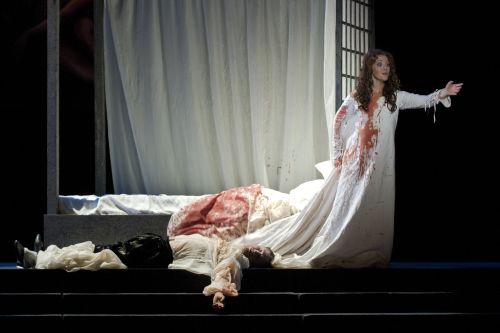 Spain Donizetti: Lucia di Lammermoor, Galicia Symphony Orchestra, Gaos Choir, Ramón Tébar (conductor), Corũna’s Palacio de la Opera, 13.09.2013 (JMI)
Spain Donizetti: Lucia di Lammermoor, Galicia Symphony Orchestra, Gaos Choir, Ramón Tébar (conductor), Corũna’s Palacio de la Opera, 13.09.2013 (JMI)

Photo (c) Amigos dela Opera de A Coruña
Cast:
Lucia di Lammermoor: María José Moreno
Edgardo: Celso Albelo
Enrico: Javier Franco
Raimondo: Giuseppe Enrico Iori
Arturo: José Francisco Pardo
Alisa: Nuria Lorenzo
Normanno: Pablo Carballido
New Production
Stage Direction: Alfonso Romero
Sets: Soc. Oxa di Mario Amodio
Costumes: Lorena Marín
Lighting: Rafael Mojas
Corũna’s Opera Festival opens the Spanish opera season. This year the program includes two performances of this Donizetti masterpiece, one concert performance of Tristan und Isolde and an opera gala featuring Gregory Kunde and Juan Jesus Rodriguez. Not bad for the times in which we live.
The performances of Lucia di Lammermoor have had a popular success, due to their simple and effective stage production, good musical direction and an excellent cast, which was almost entirely Spanish.
Alfonso Romero’s production has the virtue of combining efficiency and low cost, with sets consisting of painted backdrops for the different scenes plus some props. The costumes are well-suited and unpretentious. Romero sets the story in a very dark environment. Some of the details are not successful, especially the start of the mad scene in the bridal room, where Lucia kills Arthur; it doesn’t add anything of interest and becomes useless on stage afterwards. The idea of showing Raimondo singing his aria while he drinks from a bottle is rather gratuitous. But all in all it is a persuasive production.
This was my first chance to see Ramón Tébar, the musical director of Miami’s opera company. I must say that his conducting was fully convincing. He was always supportive of the singers, and offered a reading of the opera that was full of strength and energy. He cut the Wolf’s Crag scene, but perhaps this was not his initiative; and, in general, he cut the second verse of cabalettas, except for the duet of Raimondo and Lucia. Under his baton was the remarkable Galicia Symphony Orchestra, which is always a guarantee of success.
María José Moreno had the big triumph of the evening with her portrayal of Lucia. This soprano has her own scale of values which makes her performances less frequent than one would like. It’s now 12 years since I first saw her as Lucia, and she is in outstanding vocal shape: an excellent performer whose high notes are safer than years ago. There is no doubt that she is the best possible Lucia in Spain, and she proved that she could sing the role in the top theaters in the world.
Celso Albelo was a remarkable Edgardo, less inclined than in the past to imitate the great Alfredo Kraus. The best part of his performance was the scene in the Ravenswood Cemetery. There are not many tenore di grazia nowadays who can compete with him.
Javier Franco was an effective interpreter of Enrico but rather rough, with too many open sounds and tight at the top.
Giuseppe Enrico Iori was a good Raimondo, with a pleasant voice in the middle range but more whitish at the top. He offered some variations in the second verse of his first-act cabaletta, which is always worthy of appreciation.
Jose Francisco Pardo as Arturo offered a more important voice than what it is usually found in this character.
Palacio de la Ópera was sold out. The audience was very enthusiastic throughout the performance, to the point of getting an encore of the famous sextet. In the final bows there was an enthusiastic reception for María José Moreno, Celso Albelo and Ramón Tébar.
José Mª Irurzun